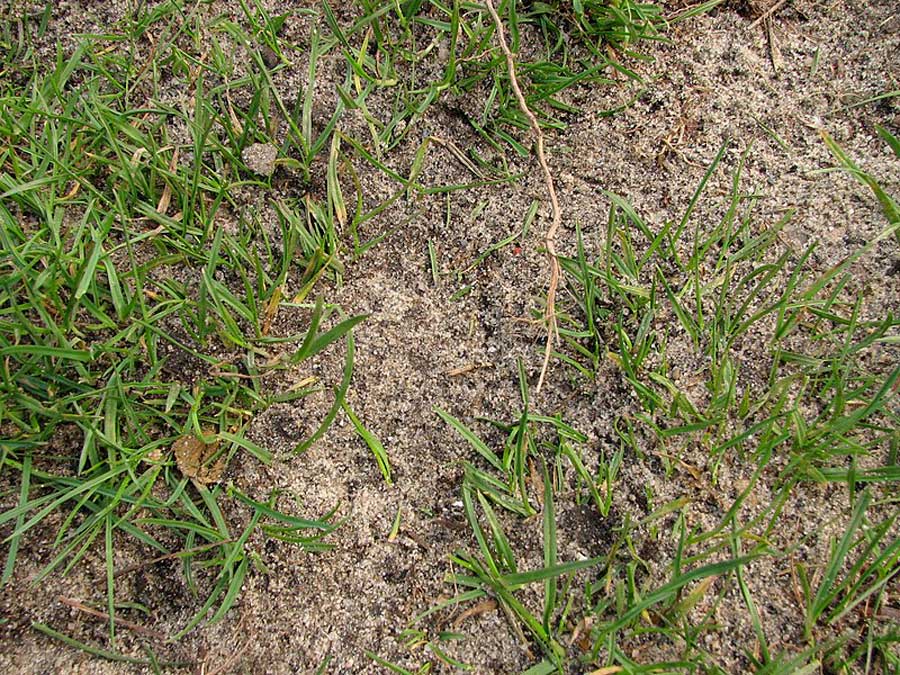The soil in your garden plays a pivotal role in determining which trees will thrive best. Sandy soil, known for its light texture and low nutrient content, can present unique challenges for tree planting.
However, there are a variety of trees that flourish beautifully in sandy soil conditions. In this article, we’ll explore the properties of sandy soil, identify 10 awesome trees suited for this environment, and share invaluable advice for successful gardening in sandy soil.
What sort of trees can you plant in sandy soil like this?

Getting to Know Sandy Soil
What is Sandy Soil?
Sandy soil is recognisable by its gritty texture and loose structure. It consists predominantly of sand particles, making it light and well-drained. Sand particles are large enough to view with the naked eye, unlike clay soil particles, and that’s what gives sand its free-draining nature.
Advantages and Disadvantages of Sandy Soil
While sandy soil’s excellent drainage prevents waterlogging, it can also lead to rapid nutrient and moisture loss. This means that trees planted in sandy soil may require more frequent watering and feeding than those in heavier soils.
However, trees that have naturally adapted to sandy environments are often more drought-hardy than other trees, particularly when they come from a dry region or are bred to be better adapted to the dry.
The light texture of sandy soil makes it easy to work with, and its ability to warm up quickly in spring can give a head start to many trees. It also allows for excellent root penetration, a factor beneficial for certain types of trees.
But sand can become hydrophobic, meaning that water is unable to penetrate the top layer, when it’s been dry for too long. We’ll discuss how to amend this below.
Selecting the Appropriate Trees for Sandy Soil
Factors to Bear in Mind
When choosing trees for sandy soil, consider their drought tolerance and nutrient needs. Some trees are adapted to survive in the rapidly draining conditions of sandy soil, while others might struggle. Soil pH is another important factor, as some trees prefer more acidic or alkaline environments.
Top 10 Trees for Sandy Soils
The “best” tree for your sandy garden will depend on the availability of sunlight, temperature, weather and your personal preferences.
Lumping plants based on their genus or even their species is helpful, but specific varieties may perform differently to plants in the same species. Perhaps a breeder bred a cultivar that’s more hardy to drought, making it more resilient in the sand. Or perhaps they focused on breeding for other traits and the plant lost its tolerance to drought.
Use this list as a helpful guide, but still make sure to read plant labels to make sure your chosen plants will thrive in your conditions.
Waterhousea floribunda (Weeping Lilly Pilly)
The Weeping lilly pilly is a versatile tree that can tolerate a range of soil conditions, including sandy soil, although it does prefer a bit of moisture without being overly wet. Its lush, weeping foliage and attractive berries make it a popular choice for sandy soil gardens.
Sweeper® Waterhousea floribunda ‘DOW20’ PBR is a myrtle rust resistant giant lilly pilly.

First on our list is Hakea, an Australian native tree that thrives in sandy soils. Known for its needle-like leaves and attractive flowers, this drought-tolerant tree can adapt to nutrient-poor conditions, making it perfect for sandy soils.
Grevillea spp.
Grevillea is another Australian native that tends to flourish well in sandy soil, with some varieties growing tall as a tree – most notably Grevillea robusta. These evergreen shrubs or trees are loved for its unique, spider-like flowers and its ability to withstand dry conditions. Its deep root system allows it to access water and nutrients from deep within the soil.
Telopea spp. (Tree Waratah)
Tree waratahs are striking Australian natives that can thrive in sandy soil. They’re known for their large, vibrant red flowers and their ability to survive in nutrient-poor conditions. Their hardiness makes them a good choice for sandy soil gardens.
Casuarina and Allocasuarina spp. (Sheoak)
Sheoaks, belonging to the native Australian Allocasuarina genus and exotic Casuarina genus, are well-suited to grow in sandy soil. They have needle-like leaves and pinecone-like fruits that often cause them to be mistaken for conifers. They’re drought-tolerant and their ability to fix nitrogen from the air also helps to enrich the nutrient-poor conditions of sandy soil.
Pinus spp. (Pine Tree)
Pine trees are a versatile group of trees that can adapt to sandy soil types. These coniferous trees have deep root systems that help them access water and nutrients from deep within the soil. Their tolerance to drought and poor soil conditions makes them a great option for sandy soil.
Robinia pseudoacacia
Robinia is a North American native tree that can thrive in sandy soil. This fast-growing shade tree is known for its fragrant, white flowers and its ability to fix nitrogen from the air, enriching the soil around it.
Olea europaea (Olive Tree)
Olive trees are Mediterranean natives that are well-adapted to sandy soil. These trees are drought-tolerant and can survive in nutrient-poor conditions, making them a good choice for sandy soil gardens. Pro tip: convince your friends to eat the intensely bitter raw olives for a good laugh.
Phoenix canariensis (Canary Island Date Palm)
The Canary Island Date Palm is a tropical tree that can adapt to sandy soil. This palm tree is known for its large, feather-like leaves and its tolerance to dry conditions. Its ability to withstand sandy, well-drained soils makes it a great addition to sandy soil gardens. Beware: the sharp tips of the frond’s leaf tips are prone to cause injuries when pruning the dead leaves off at the base or as they drop when the plant becomes tall.
Jacaranda mimosifolia
Last but not least, the Jacaranda tree is a South American native that can thrive in sandy soil. This tree is known for its stunning display of purple (or white) flowers and its fern-like (or mimosa-like) leaves. Its ability to tolerate poor soil conditions makes it a good choice for sandy soil gardens.
Who doesn’t love a good jacaranda tree in full bloom?

Tips for Gardening in Sandy Soil
Improving Soil Structure Before You Plant Trees
Improving the structure of your sandy soil can significantly boost your success in tree planting. Adding organic matter such as compost or well-rotted manure can increase the soil’s water-holding capacity and nutrient content.
However, organic matter is the reason for hydrophobic soils because natural plant waxes coat the large particles when there’s not enough moisture to support the soil organisms that would otherwise break them down.
Incorporating a quality hydrogel like Terracottem or a kaolin clay like Soil Solver can help hold moisture and nutrients as a longer-term solution to assist the organic matter to do its job.
Proper Watering Techniques
Proper watering is critical in sandy soil gardening. Due to its rapid drainage, trees in sandy soil may need watering more often, especially during dry periods, especially if there’s little organic matter or other amendments.
However, it’s still important not to overwater, as this can leach away nutrients.
Conclusion
While gardening in sandy soil may come with unique challenges, with the right tree selection and care, you can create a thriving garden. Experiment and plant trees listed in this article and utilise the tips shared for successful sandy soil gardening. Happy gardening!
